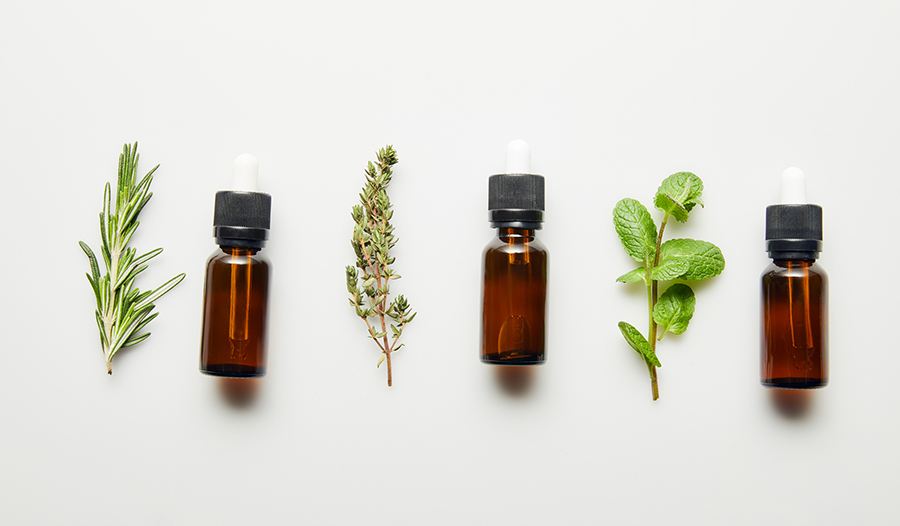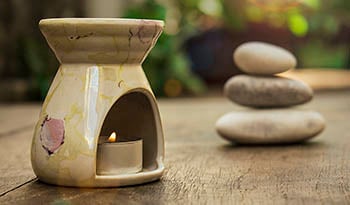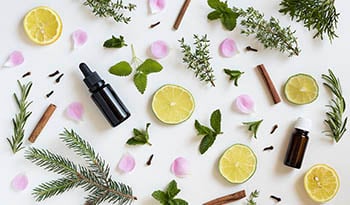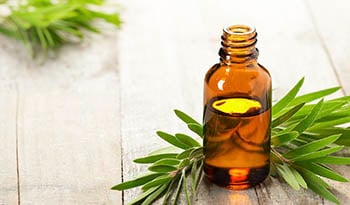Here Are The Top 9 Essential Oils of 2019
DISCLAIMER:This blog does not intend to provide diagnosis...
- In this article:
- Lavender
- Jojoba Oil
- Tea Tree
- Peppermint
- Lemongrass
- Eucalyptus
- Orange Essential Oil
- Lemon
- Rosemary

Time to bust out the diffuser.
For centuries, people across the globe have understood the benefits of essential oils. There is evidence they were utilized as far back as ancient Egypt in mummification and ceremonial celebrations, and these highly revered oils have even been used as currency throughout history.
Essential oils are still in use today for many purposes. Their pleasant aromas make them ideal for fragrances and perfumes, and they are still prized for their potential health benefits. Diffusers are a popular way to experience essential oils, along with topical and internal usage.
Note: it is very important to always read the label as some oils cannot be taken orally or used directly on skin.
Here are the top 9 essential oils for 2019.
Lavender
Lavender’s sweet smell makes it one of the most well known and recognized of all essential oils. Its distinctive purple color makes lavender a favorite in home gardens, and its leaves are also frequently collected, dried, and used for a variety of purposes. These days, it is a common additive in both foods and cosmetics.
Part of the mint family, lavender and its oil has been used for thousands of years by cultures all over the world. Scientists have extracted over 100 phytochemicals from the lavender plant.
While its earliest recorded use was by the Greeks and Romans, lavender has traditionally been used to help reduce anxiety and as an antiseptic.
Lavender can be used for the following:
- Stress – Inhaling lavender can help reduce physical and mental stress levels
- Anxiety – Lavender helps reduce anxiety levels
- Insomnia – Helps improve the quality of sleep if used topically and inhaled
- Blood pressure – A 2017 study showed lavender lowered blood pressure after open-heart surgery while a 2015 study also showed blood pressure benefits
- Antifungal and antibacterial needs
- Bug bites – Helps minimize risk of infection and reduces itching when applied topically
- Mild burns – Helps reduce pain from burns. Apply directly or mix with coconut oil
- Eczema – Apply directly on dry skin or mix with coconut oil to relieve symptoms
- Pain relief – Helps provide relief to sore muscles and joints when applied during a massage
- Pain relief during surgery – Studies show use of lavender during surgery reduces pain levels
- Carpal tunnel syndrome – A 2017 study in the Journal of Hand Therapy showed lavender reduced wrist pain when applied topically
Lavender essential oil blends well with clove and rosemary oils. Note: some people may experience sensitivity to topical application as it may elicit an allergic response.
Jojoba Oil
Jojoba (simmondsia chinensis) oil is a waxy substance that comes from the seed of the drought-resistant perennial plant of the same name. Native to the Southwestern United States and Northern Mexico, Jacobs has been prized for its oil for centuries. The oil has traditionally been used topically to treat wounds and sores, and it can also be used in a diffuser or even mixed with other essential oils to create a custom relaxing aroma. It is also frequently applied topically.
Jojoba oil is known for the following properties:
- Hydration
- Anti-aging
- Wound healing
- Antioxidant
- Antibacterial
- Acne-fighting
- Soothing (especially for sunburns)
Mixes well with eucalyptus, peppermint, thyme, rosemary, and lavender oils.
Tea Tree
Tea tree oil is derived from the leaves of the Melaleuca tea tree. It is mostly found in Australia, where it has been used as a medicine by the Aborigines for hundreds of years. The aroma of tea tree is described as medicinal and fresh by some, and similar to camphor by others. The name is attributed to British sailor Captain James Cook and has no relation to the beverage.
Tea tree has many benefits:
- Antifungal – Studies have shown that this oil has antifungal properties. I have frequently advised its use for patients seeking a first-line treatment for nail fungus. I recommend applying it once to twice per day to the nail and have seen good results when used consistently. It can also be applied to the skin to help treat athlete’s foot.
- Antibacterial – A 2017 study in mice showed inhaled tea tree oil could be helpful in fighting pneumonia. More research is needed before it is used in people this way.
- A 2017 study out of Rome, Italy, showed rinsing the mouth out with tea tree oil was helpful for those with inflammation due to gingivitis
- Wound healing – Apply topically to help prevent infection
- Helps control dandruff – Apply topically to the scalp to help reduce flaking
CAUTION: Do not ingest tea tree oil orally due to risk of serious side effects, such as confusion and loss of muscle control. Some can also be sensitive to topical application.
Tea tree blends well with lavender and myrrh oils.
Peppermint
Peppermint is a well-known herb and essential oil. A hybrid of watermint and spearmint, its smell is sharp and fresh, and it’s one of its main components is menthol. In recent times, peppermint has been used as a flavoring in chewing gum, and it is still well regarded for its numerous health benefits.
Peppermint can aid with the following:
- Irritable bowel syndrome (IBS) symptoms
- Headaches, especially tension headaches
- Nail infections - Applied topically, can help with fungal infections
- Skin infections – A 2012 study showed protection against skin infections
- Upper respiratory infection
- Itching due to pregnancy – Topically applied, peppermint helps minimize itching due to pregnancy, according to studies. Avoid oral consumption.
- Eczema – Topically applied, helps minimize skin irritation
- Hair growth – A 2014 study in Toxicological Research demonstrated when peppermint was applied topically, it could help with hair growth
Peppermint blends well with lavender, rosemary and eucalyptus oils.
Lemongrass
Although similar in name, lemongrass essential oil and lemon essential oil come from two different plants. Lemongrass oil comes from the perennial cymbopogon plant and can be ingested orally, applied topically, or used in a vaporizer. It is also commonly used for flavoring. Its active ingredient is limonene.
Benefits of lemongrass include:
- Natural insect repellent
- Antioxidant properties
- Antibacterial properties
- Anti-inflammation for skin conditions
- Anti-anxiety properties
- Dandruff relief
- Sore muscle relief when applied topically
- Reduces inflammation and pain in rheumatoid arthritis
Eucalyptus
Eucalyptus is a genus that consists of over 700 species, most of which are evergreen. The plant, which is covered in oil glands, is native to Australia, where the Aborigines have used eucalyptus as a medicine for almost a thousand years. The herb is commonly found in gums, toothpaste, and cough drops.
The oil extracted from eucalyptus leaves has antiseptic and disinfectant properties. If the leaves or oils are consumed in large quantities, they can be toxic. However, Koalas and opossums are able to safely consume the leaves and rely on them as a primary food source. Note: Avoid oral consumption of the essential oil.
Benefits of eucalyptus oil include:
- Upper respiratory infection relief – Inhalation of an herbal mixture containing eucalyptus minimizes symptoms of infection, according to studies
- Antibacterial properties – A 2012 study showed protection against bacterial skin infections when applied topically
- Antifungal properties – Eucalyptus applied topically can kill fungus
- Natural deodorant usage – Apply topically to the armpits
Eucalyptus blends well with lavender and lemon oils.
Orange Essential Oil
The orange is one of the most common citrus fruits and subsequently one of the most popular essential oils. A hybrid between two other citrus fruits, a mandarin and pomelo, the orange’s origins go back to ancient China, where it was first mentioned in literature around 314 BCE.
The Spanish are believed to have brought the orange to North America and likely planted the first tree in Hispaniola, the island of modern-day Haiti and Dominican Republic. Oranges became popular amongst sailors once it was realized that the vitamin C in an orange could help prevent the dreaded scurvy.
As an essential oil, its sweet, relaxing, and familiar scent creates a pleasant environment. It can be applied topically, diffused, or consumed orally. The oil is extracted from the rind.
Orange oil is known for its many benefits:
- Antibacterial properties
- Inhibits growth of lung tumors in studies
- Anti-inflammatory
- Green pesticide (disrupts ant trails)
- Kills red fire ants
- Encourages growth of lactobacillus in the gut
Blends well with cinnamon.
Lemon
Lemon is a familiar scent, sour and sweet at the same time. The tree is native to South Asia, specifically North East India. Lemon entered Europe around 200 AD, and its use can be traced to Egypt around 700 AD.
The lemon fruit is rich in vitamin C. Extracted from the peel, its oil has many uses and is widely featured in beauty products due to its antioxidant properties. Additional, a 2014 study concluded, “Lemon scent can be effective in reducing nausea and vomiting of pregnancy.”
It also has many other benefits:
- Anti-anxiety and antidepressant properties when inhaled vaporized
- Antibacterial properties when applied topical
- Stimulates alertness when inhaled
- Wound healing assistance – When applied topically
- Indigestion aid – Taken with a glass of water, it can stimulate the digestive process
- Insect repellant – When applied topically, it helps keep insects away
- Disinfectant – Mixed with water, it can be used to gently clean surfaces
- Sore throat – Antioxidant properties helps kill viruses in the throat
- Skincare – Mixed with coconut oil and applied to the skin, it helps protect against oxidation and aging changes.
Lemon oil blends well with eucalyptus oil.
Rosemary
Rosemary is a common perennial herb whose flowers vary in color from white, purple, and blue, to sometimes pink. The flower normally blooms during spring and summer in the Northern Hemisphere and is native to the Mediterranean region. The name is Latin in origin and translates to “dew of the sea”.
Rosemary was first written about by the Egyptians as far back as 5,000 BCE. In addition, the Egyptians used this herb in their burial ceremonies. It appears that rosemary was brought to China sometime around 200 AD and Europe in the 1300s.
Rosemary contains polyphenols, which have antioxidants, anti-inflammatory, cholesterol-lowering and glucose-stabilization properties.
Rosemary has been shown to have many health benefits and, according to an article in the New York Times, rosemary plays a big part in the diet of one of the world’s healthiest and oldest living populations, those who reside in Acciaroli, Italy. Rosemary can be used for the following:
- Memory – A 2017 study concluded, “Inhalation of rosemary essential oil increased the memorization of numbers”
- Traumatic Brain Injury (TBI) – A 2016 study using animals showed improved brain function in injured subjects
- Hair loss – A 2015 study showed improved hair growth when applied topically to the scalp. It took six months, however, for a difference to be seen
- Muscle spasms – This essential oil helps to relax muscles when used during a massage
- Antioxidant protection – Rosemary is a potent antioxidant, according to studies
CAUTION: Some may be sensitive to this essential oil and a few have had skin reactions.
Rosemary blends well with lavender and peppermint oils.
References:
- Salamati A, Mashouf S, Mojab F. Effect of Inhalation of Lavender Essential Oil on Vital Signs in Open Heart Surgery ICU. Iranian Journal of Pharmaceutical Research : IJPR. 2017;16(1):404-409.
- Complement Ther Med. 2015 Jun;23(3):331-8. doi: 10.1016/j.ctim.2014.12.001. Epub 2014 Dec 11.
- Complement Ther Clin Pract. 2016 Nov;25:75-80. doi: 10.1016/j.ctcp.2016.08.002. Epub 2016 Aug 3.
- J Hand Ther. 2017 Aug 10. pii: S0894-1130(16)30251-4. doi: 10.1016/j.jht.2017.07.004. [Epub ahead of print]
- Ranzato E., Martinotti S., Burlando B. Wound healing properties of jojoba liquid wax: An in vitro study. J. Ethnopharmacol. 2011;134:443–449. doi: 10.1016/j.jep.2010.12.042.
- Jojoba in dermatology: a succinct review. Pazyar N, Yaghoobi R, Ghassemi MR, Kazerouni A, Rafeie E, Jamshydian N G Ital Dermatol Venereol. 2013 Dec; 148(6):687-91.[1] Lin TK, Zhong L, Santiago JL. Anti-Inflammatory and Skin Barrier Repair Effects of Topical Application of Some Plant Oils. Int J Mol Sci. 2017;19(1):70. Published 2017 Dec 27. doi:10.3390/ijms19010070
- Meier L., Stange R., Michalsen A., Uehleke B. Clay jojoba oil facial mask for lesioned skin and mild acne—Results of a prospective, observational pilot study. Forsch Komplementmed. 2012;19:75–79. doi: 10.1159/000338076.
- J Pharm Pharmacol. 2017 Aug 15. doi: 10.1111/jphp.12788.
- Phytomedicine. 2012 Aug 15;19(11):969-76. doi: 10.1016/j.phymed.2012.05.014. Epub 2012 Jun 26.
- Akhavan Amjadi M, Mojab F, Kamranpour SB. The Effect of Peppermint Oil on Symptomatic Treatment of Pruritus in Pregnant Women . Iranian Journal of Pharmaceutical Research : IJPR. 2012;11(4):1073-1077.
- Oh JY, Park MA, Kim YC. Peppermint Oil Promotes Hair Growth without Toxic Signs. Toxicological Research. 2014;30(4):297-304. doi:10.5487/TR.2014.30.4.297.
- Acta Pharm. 2018 Jun 1;68(2):185-197. doi: 10.2478/acph-2018-0015. (lemongrass antioxidant)
- Liakos IL, Grumezescu AM, Holban AM, et al. Polylactic Acid-Lemongrass Essential Oil Nanocapsules with Antimicrobial Properties. Pharmaceuticals (Basel). 2016;9(3):42. Published 2016 Jul 7. doi:10.3390/ph9030042
- Han X, Parker TL. Lemongrass (Cymbopogon flexuosus) essential oil demonstrated anti-inflammatory effect in pre-inflamed human dermal fibroblasts. Biochim Open. 2017;4:107–111. Published 2017 Mar 21. doi:10.1016/j.biopen.2017.03.004
- J Altern Complement Med. 2015 Dec;21(12):766-73. doi: 10.1089/acm.2015.0099. Epub 2015 Sep 14. (Lemongrass and anxiety)
- Forsch Komplementmed. 2015;22(4):226-9. doi: 10.1159/000432407. Epub 2015 Jul 14 (Lemongrass and dandruff)
- Meenapriya M et al /J. Pharm. Sci. & Res. Vol. 9(2), 2017, 237-239 237 (http://jpsr.pharmainfo.in/Documents/Volumes/vol9Issue02/jpsr09021734.pdf)
- Phytomedicine. 2012 Aug 15;19(11):969-76. doi: 10.1016/j.phymed.2012.05.014. Epub 2012 Jun 26.
- Nat Prod Res. 2017 Mar;31(6):653-659. doi: 10.1080/14786419.2016.1219860. Epub 2016 Aug 18.
- Molecules. 2017 Aug 22;22(8). pii: E1391. doi: 10.3390/molecules22081391.
- J Econ Entomol. 2017 Aug 1;110(4):1556-1562. doi: 10.1093/jee/tox120.
- J Sci Food Agric. 2019 Jun;99(8):4019-4028. doi: 10.1002/jsfa.9629. Epub 2019 Mar 12.
- Yavari Kia P, Safajou F, Shahnazi M, Nazemiyeh H. The effect of lemon inhalation aromatherapy on nausea and vomiting of pregnancy: a double-blinded, randomized, controlled clinical trial. Iran Red Crescent Med J. 2014;16(3):e14360. doi:10.5812/ircmj.14360
- Behav Brain Res. 2006 Sep 25;172(2):240-9. Epub 2006 Jun 15.
- Naimi M, Vlavcheski F, Shamshoum H, Tsiani E. Rosemary Extract as a Potential Anti-Hyperglycemic Agent: Current Evidence and Future Perspectives. Nutrients. 2017;9(9):968. Published 2017 Sep 1. doi:10.3390/nu9090968
- https://www.nytimes.com/2016/10/20/world/what-in-the-world/rosemary-and-time-does-this-italian-hamlet-have-a-recipe-for-long-life.html?_r=0
- O.V. Filiptsova, L.V. Gazzavi-Rogozina, I.A. Timoshyna, O.I. Naboka, Ye.V. Dyomina, A.V. Ochkur, The essential oil of rosemary and its effect on the human image and numerical short-term memory, In Egyptian Journal of Basic and Applied Sciences, Volume 4, Issue 2, 2017, Pages 107-111.
- Neurosci Lett. 2016 May 27;622:95-101. doi: 10.1016/j.neulet.2016.04.048. Epub 2016 Apr 22.
- Skinmed. 2015 Jan-Feb;13(1):15-21. Rosemary helps hair growth
- Pathophysiology. 2017 Sep 14. pii: S0928-4680(17)30005-6. doi: 10.1016/j.pathophys.2017.08.002.

 By Dr. Eric Madrid, M.D.
By Dr. Eric Madrid, M.D.


